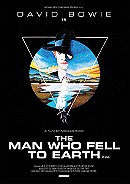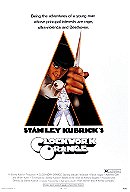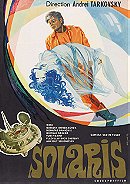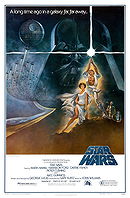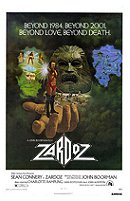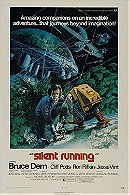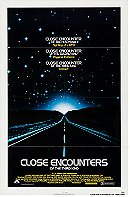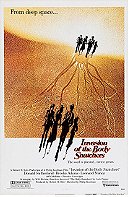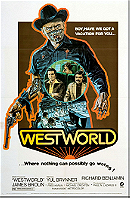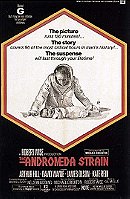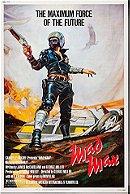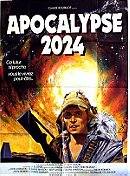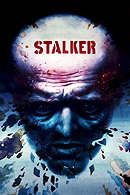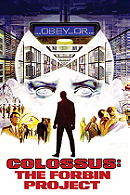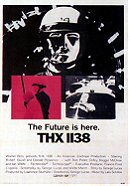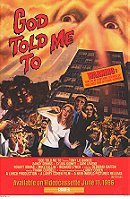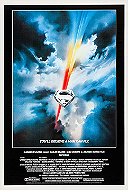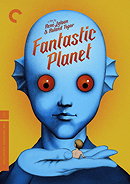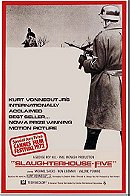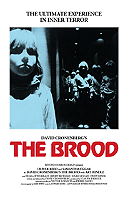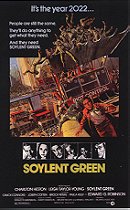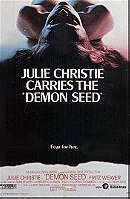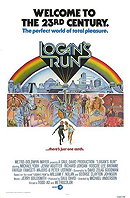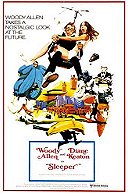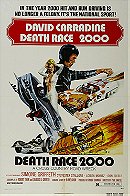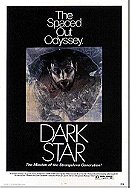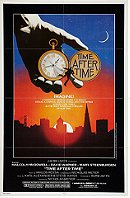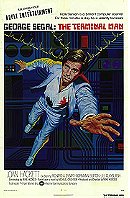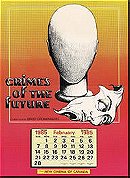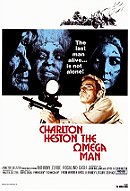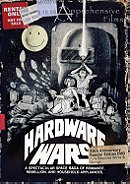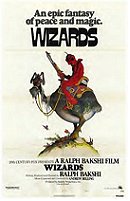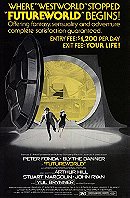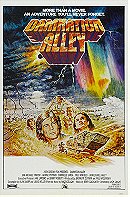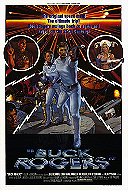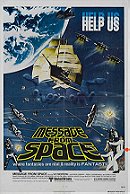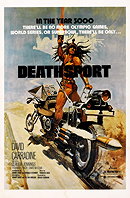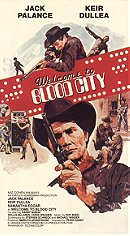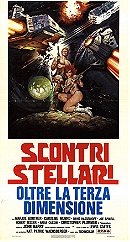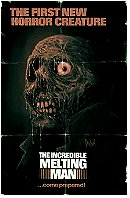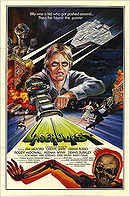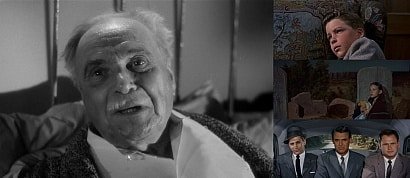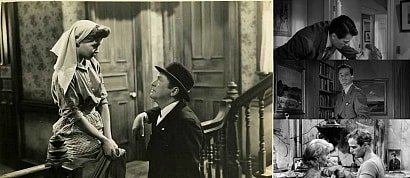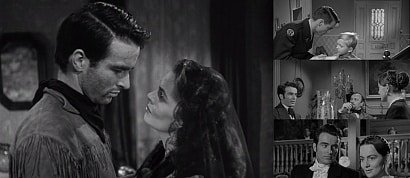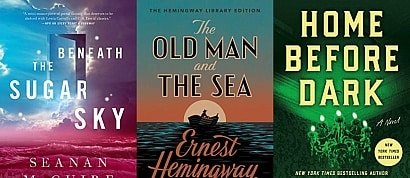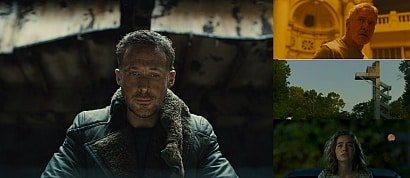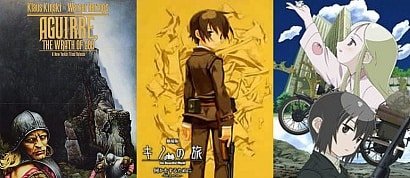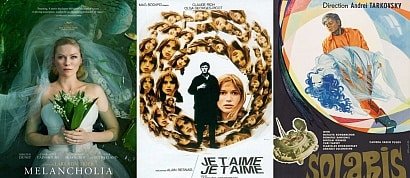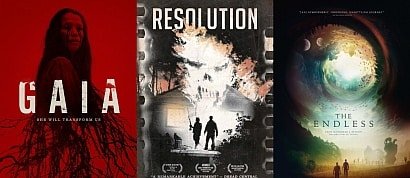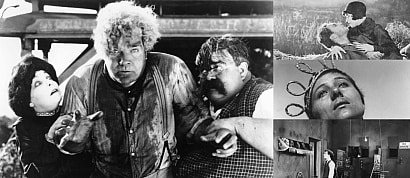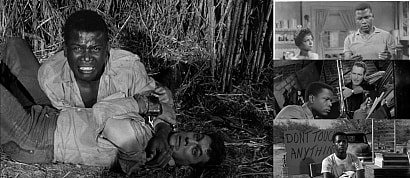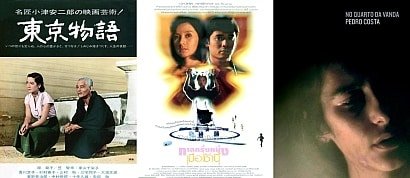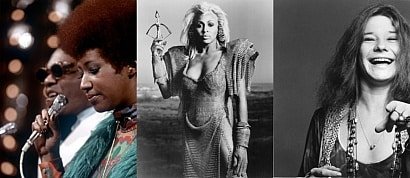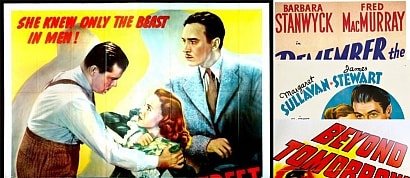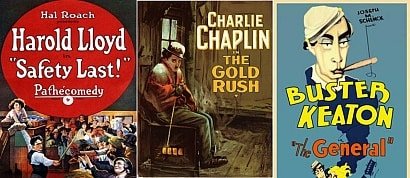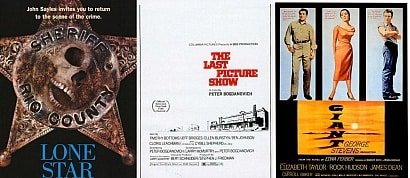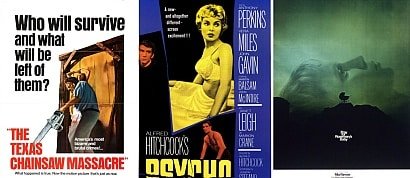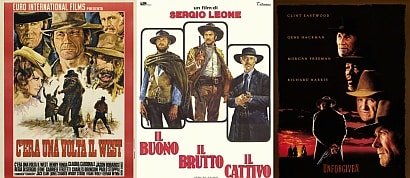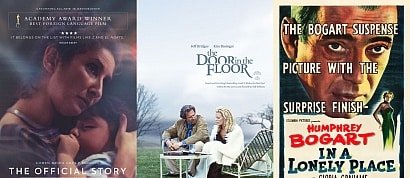RS: 50 Best Sci-Fi Movies of the 1970s
Sort by:
Showing 50 items
Decade:
Rating:
List Type:
From cosmic head trips to adventures in galaxies far, far away
It was the decade that gave the world the maverick New Hollywood drama, the Nixon-era paranoid thriller, the slasher flick, the all-star disaster movie, the gross-out comedy and the modern mega-blockbuster. But the Seventies were particularly kind to one specific cul-de-sac of cinema: the science fiction film, a subset category that was still buzzing from its late-Sixties head-trip phase courtesy of 2001: A Space Odyssey. As the Age of Aquarius slowly slid into the beginning of the nation’s Watergate-and-disco period, you could still find sci-fi movies that wanted to blow an audience’s possibly addled, probably enhanced mind. But by the end of the 1970s, it was possible to have checked out postapocalyptic action-adventures, future-shock case studies, technophobic nightmares, low-budget exploitation movies about what-if scenarios and big-budget space operas — all of which fell under the S.F. umbrella and helped turn the genre into a gamechanger. And as anyone who saw Guardians of the Galaxy or Interstellar last year will tell you, the influences of this period are still showing up in theaters near you.
So, in honor of the 10-year-period that made science-fiction filmmaking what it is today, we are counting down the 50 best sci-fi movies of the 1970s. Some of them belong in the greatest-of-all-time canon; others, we will fully admit, are the cinematic equivalent of a ripe Camembert. But each of these helped the decade redefine where science fiction could go on the big screen, whether it was in a grungy grindhouse or a state-of-the-art multiplex. This is where the genre genuinely started to boldly go where it had never gone before.
It was the decade that gave the world the maverick New Hollywood drama, the Nixon-era paranoid thriller, the slasher flick, the all-star disaster movie, the gross-out comedy and the modern mega-blockbuster. But the Seventies were particularly kind to one specific cul-de-sac of cinema: the science fiction film, a subset category that was still buzzing from its late-Sixties head-trip phase courtesy of 2001: A Space Odyssey. As the Age of Aquarius slowly slid into the beginning of the nation’s Watergate-and-disco period, you could still find sci-fi movies that wanted to blow an audience’s possibly addled, probably enhanced mind. But by the end of the 1970s, it was possible to have checked out postapocalyptic action-adventures, future-shock case studies, technophobic nightmares, low-budget exploitation movies about what-if scenarios and big-budget space operas — all of which fell under the S.F. umbrella and helped turn the genre into a gamechanger. And as anyone who saw Guardians of the Galaxy or Interstellar last year will tell you, the influences of this period are still showing up in theaters near you.
So, in honor of the 10-year-period that made science-fiction filmmaking what it is today, we are counting down the 50 best sci-fi movies of the 1970s. Some of them belong in the greatest-of-all-time canon; others, we will fully admit, are the cinematic equivalent of a ripe Camembert. But each of these helped the decade redefine where science fiction could go on the big screen, whether it was in a grungy grindhouse or a state-of-the-art multiplex. This is where the genre genuinely started to boldly go where it had never gone before.
Alien (1979)
Outside of Jaws’ prolonged tease that leads to its money-shot shark reveal, no Seventies spectacle builds its dread and anticipation toward one scene as beautifully as director Ridley Scott’s extra-terrestrial horror. (No matter how many times you’ve seen it, the alien’s violent explosion from Kane’s stomach is deeply, profoundly upsetting.) Before we get to That Scene, Alien is merely one hell of an office drama in space — a submarine thriller set among the stars. Then it morphs into a haunted-house chiller dropped into the cosmos, creating unbearable tension from the film’s close-quarters locale. At the movies, outer space was once a source of wonder, curiosity, adventure — after Alien, it was a new canvas for our nightmares, a place where no one could hear you scream. TG
JxSxPx's rating:


The Man Who Fell to Earth (1976)
Bearing no traces of the tropes that helped tame the genre throughout the decade, Nicolas Roeg’s adaptation of Walter Tevis’s novel remains a breathlessly in-the-moment, sui generis creation. David Bowie is Thomas Jerome Newton, a scarlet-haired alien sent to earth to secure water for his own dehydrated planet. After he hustles a multimillion-dollar fortune out of high-tech patents, the beanpole androgyne becomes waylaid from his mission, mesmerized by serial distractions such as a comely elevator operator (Candy Clark) and the constant cacophony of American television, preferably viewed en masse. For Roeg, loneliness and ennui aren’t just colors in a crayon box; they’re harrowingly consequential states of mind and being. You’re damn right the alien is you. EH
JxSxPx's rating:


A Clockwork Orange (1971)
riticized and condemned upon its release — director Stanley Kubrick even pulled it out of circulation in the U.K. for a time — A Clockwork Orange may seem relatively tame by today’s cinematic standards for society-in-moral-free-fall dystopias. But few of this extreme satire’s successors are as hilarious. Led by Malcolm McDowell’s liberatingly bratty performance as the degenerate droog Alex, this adaptation of Anthony Burgess’ 1962 novel remains bitterly funny (and wise) about all the ways that conformity and government oppression conspire to break our spirit. Serious enough about its message to deliver it as farce, Orange is a bleak cautionary tale headlined by one marvelously charming bastard. TG
JxSxPx's rating:


Based on a novel by Polish author Stanislaw Lem, Solaris doesn’t transcend its genre so much as seriously elevate it. The defining movie of the Soviet cosmonaut era isn’t a story of heroism, collectivism, or technological innovation, but a disorienting head-trip about memory, loss, and guilt. Sent to investigate a space station in which the two remaining inhabitants have been driven mad by mysterious forces, a psychologist (the brooding Donatas Banionis) is immediately haunted by his dead ex-wife, who’s not just an apparition but a physical presence. The swirling Solarian sea is designed like a day-glo Rothko, and filmmaker Andrei Tarkovsky envisions weightlessness as a foreboding, paranormal affliction — but what Solaris is really after is the ineffability of inner space. EH
Star Wars: A New Hope (1977)
Even after close to 40 years of exhaustive reckoning, it’s hard to overestimate the cultural and economic significance of George Lucas’ pulpy, pop-inflected space opera. While it nostalgically riffed on Flash Gordon serials, Greek and Anglo mythology, and Leni Reifenstahl-cribbed triumphalism, the filmmaker was nevertheless prescient about both world and market building. That we’re about to receive a third trilogy based on characters first introduced in 1977 certainly speaks to the film’s enduring appeal — indeed there’s never been anything quite like it. And while all other sci-fi films from the Seventies can’t help but be products of their era, Lucas has done everything he can — from digitally upgrading analog effects to backdating the introduction of characters — to prevent it from becoming a relic. His project wasn’t to make a movie about that or any other time, but rather a story that lives off the screen, all the time. We’re all still living in it. EH
JxSxPx's rating:


Zardoz (1974)
It’s 2293, and the world is divided between impotent, midriff-baring hippies and illiterate, bedraggled savages. To keep the latter in check, a giant stone head deity floats over the landscape and goads men in red diapers to kill people at will. One of these “exterminators” is a mostly naked, obscenely hirsute Sean Connery, who singlehandedly subverts the class system by infiltrating an anesthetized Garden of Eden and inducing ice queen Charlotte Rampling into obsessing over his erection. One half vintage acid trip and one half devious social satire (director John Boorman tellingly pits SoCal mystics against armed radicals), this legendarily ludicrous spectacle has more to offer than James Bond swinging around a braided ponytail for 105 minutes — and that’s saying something. EH
JxSxPx's rating:


A movie that has everything — if by everything you mean Bruce Dern as a long-haired homicidal intergalactic treehugger playing poker with droids, talking to bunnies, and feeling really passionately about salad. The directorial debut of visual effects wiz Douglas Trumbull, Silent Running is a deceptively grim environmentalist allegory about a conservationist who balks at destroying the greenhouses he’s immaculately maintained aboard a giant space freighter. Though in the moral right, Dern’s crazy-eyed rants about his predicament foretell a very dark turn, which leaves him alone with nothing but his self-righteousness, guilty conscience, and the aforementioned droids. A singularly bonkers effort that nevertheless taught Star Wars a thing or two about dodderingly cute robots and gave Mystery Science Theater its bored in space conceit. EH
Phase IV (1974)
The only feature directed by legendary graphic designer Saul Bass concerns a colony of hyperintelligent ants intent on taking over the world, but it’s less a creature feature than the equivalent of taking mushrooms with a bunch of hip myrmecologists. As the ants trap a group of scientists in their isolated desert lab, it becomes clear they don’t want to wipe out humanity so much as (literally) colonize it — an idea played out over the film’s recently rediscovered ending, a heady montage that gives 2001‘s “Beyond the Infinite” a run for its money. SA
When was the last time you watched the first fruit of Steven Spielberg’s post-Jaws harvest? Did you remember the extended, door-slamming scenes of marital discord between Richard Dreyfus and Teri Garr? Did you remember how long Spielberg delays the big reveal? Did you remember how easily Dreyfuss agrees to board the spaceship? Unlike 1977’s other sci-fi blockbuster, Star Wars, the secret to Close Encounters of the Third Kind’s greatness is how it takes the time to immerse us in a swirl of Seventies paranoia and Reader’s Digest-derived mysticism before blowing us away with a Manhattan-sized mothership. Four decades after Orson Welles warned of marauding Martians, Spielberg gave us a wholly friendly alien visitation, complete with oh-hey totally harmless abduction of a toddler, frenzied keyboard-based attempts at communicating, and a luminescent, kind-eyed species of being that has the rare power to tame Francois Truffaut. EH
JxSxPx's rating:


Easily among the greatest remakes ever made, Philip Kaufman updates Don Siegel’s McCarthy-era classic to 1978 San Francisco. Donald Sutherland’s trench-coated health inspector discovers that citizens are transforming into dead-eyed replicas of themselves. Like a deathblow to the wounded remains of the Sixties, the mysterious affliction drives people to distrust their neighbors, their community, and the environment. Kaufman proves singularly adept at keeping multiple genres and tones in play, from noirish mystery to heady paranormal thriller to face-squishing sci-fi horror. There’s truly no recovering from the film’s final the enemy-is-us parting shot. EH
JxSxPx's rating:


In the future, rich tourists tired of traditional vacations can visit three adult theme parks in which lifelike robots cater to their every need. But after a series of malfunctions, the androids begin murdering their guests, leading to a final standoff involving Yul Brynner as a surly, trigger-happy gunslinger. Michael Crichton’s 1973 film foresaw the rise of computer viruses and was one of the first to utilize CGI technology that would become commonplace years later. While the graphics may look dated now, the film remains a prescient look at the evil cinematic conglomerates found in everything from the Robocop to Blade Runner. Also, murderous cowboy robots will always be a sci-fi geek’s cinematic wet dream. JN
JxSxPx's rating:


Norman Jewison’s extreme-sports future shock bundles together a paranoid political thriller, a McLuhan-drunk media satire, ultraviolent exploitation, reverent respect for faddish athletic pursuits and enough zoom shots to make Robert Altman blush. You also get James Caan as the greatest competitor in the history of rollerball — a wildly popular bloodsport that combines roller derby, motorcross, football and boxing. In this fucked-up future, corporate rule has toppled the nation state, leading executives to rig the game so that sportsmen like Caan’s champion ‘baller can’t realize the power of their popularity. The skate-rink action, which culminates in an apocalyptic death match, remains rabble-rousingly brutal. EH
JxSxPx's rating:


A precursor to the biohazard thrillers that have occasionally infected multiplexes over the past 20 years, Robert Wise’s adaptation of Michael Crichton’s novel about a deadly space pathogen trades in the genre’s cosmic pulp and head-trippiness for a procedural-like seriousness. Having discovered a downed satellite has brought back a spore — code name: Andromeda — that threatens to wipe out humanity, a team of scientists have to contain this lethal visitor or die tryin’. The era’s predilection for sterile white environments and emphasis on the first part of the term “science fiction” gets a nice workout here, as will your nervous system. Germaphobes, proceed with extreme caution. DF
JxSxPx's rating:


Mad Max (1979)
Part down-under Western, part Seventies vigilante thriller and part action-packed postapocalyptic road movie, this landmark Ozploitation movie imagines a war-ravaged future in which cops like “Mad Max” Rockatansky are the only things that stand between lawless biker gangs and what’s left of civilization. George Miller’s vision of a dystopia-as-demolition-derby helped turn Mel Gibson into an international star; thanks to a bad overdubbing job regarding the Aussie accents, it initially stiffed in America. By the time its superior sequel The Road Warrior showed up a few years later, the original had become a bona fide cult classic. CC
JxSxPx's rating:


A Boy and His Dog (1975)
When you’re living in a scorched-earth hellhole where canned goods replace money and violence is the lingua franca, getting laid may not be your first natural instinct. But that’s what makes this bizarre, low-budget satire based on a Harlan Ellison novella so effective. Vic (a pre-Miami Vice Don Johnson) is a perpetually horny teenage itinerant who speaks telepathically with his dog Blood. When an underground group needs a sperm donor to repopulate their society, Vic is happy to offer his services. Ellison’s source material may have been used to better effect in a number of other films since its release, but the singular, sick-as-fuck satire has more than earned its status as a cult classic. JN
JxSxPx's rating:


A rough-hewn hired guide brings two intellectuals to a forbidden, possibly radioactive Russian territory called “The Zone.” Over the course of a single day, the men traipse around an overgrown, abandoned structure, and eventually enter a room that’s believed to have the power to satisfy someone’s deepest wish. It’s the reverence and trepidation of the visitors that imbues the space with magic — much as Andrei Tarkovsky’s movie camera can make a flowing brook, a bird flying overhead, or a phone ringing in empty house into a knee-buckling act of god. EH
Colossus: The Forbin Project (1970)
Fourteen years before The Terminator (and only two years after HAL refused to open the pod door), there was another, lesser-known tale of a supercomputer seizing control of the world and trying to eradicate humanity. Smug engineer Dr. Charles A. Forbin, who convinces the U.S. Defense Department to let his “Colossus” control the country’s nuclear arsenal, then watches in horror as his creation goes over his head and starts communicating with the Soviet’s own electronic brain. Scientific cockiness drives the story: As a representative of humanity’s best and brightest brainiacs, the doctor builds a machine smart enough to realize that mankind is teeming with arrogant jerks like himself — all of whom need to be purged in the name of peace. NM
JxSxPx's rating:


THX 1138 (1971)
As visually and sonically stunning as anything George Lucas would later do in a galaxy far far away, his future-fascistic nightmare is a pure product of the decade’s New Hollywood renaissance, exploring sex, drugs, mind-numbing television, governmental malfeasance, and both the necessity and futility of rebellion. Robert Duvall is quietly tremendous as the movie’s equivalent of 1984‘s Winston Smith. It’s not just a film, it’s a jumping-off point for an alternate universe in which George Lucas’s body of work veers closer to Sixties cerebral sci-fi than Thirties serials. STC
JxSxPx's rating:


Grindhouse auteur Larry Cohen wasn’t the first to surmise that God might be an alien, but he was the first to suggest that extraterrestrials might possess humans’ minds and send them on a mass killing spree. Featuring citizens falling to sniper fire as they cross the street, God Told Me To embodies the sordid grit of mid-Seventies Manhattan, where hard-nosed detective Tony Lo Bianco has his faith tested and his mind blown by a case that leads him to investigate the very nature of humanity itself. The mixture of high-flown philosophy and greasy cop thriller often feels like watching two movies projected on the same screen — an unsettling, sometimes perplexing, definitely unforgettable experience. SA
JxSxPx's rating:


Superman (1978)
In light of today’s fixation on “dark” superhero tales, Richard Donner’s fidelity to the DC comics plays as positively unfussy and wholesome in retrospect. But like its 21st century brethren, this is no B-movie cheapie — it’s a $55 million, franchise-launching behemoth that employed Oscar winners Marlon Brando and Gene Hackman, as well Godfather scribe Mario Puzo, to make you believe a man could fly. As epitomized by Christopher Reeve’s throwback movie-star charisma, there’s more vintage screwball pizzazz and widescreen spectacle than malaise-days grit here, though Margot Kidder’s E.R.A-era Lois Lane helps bring things up to speed. While Hackman steals the show as a dastardly dandyish Lex Luthor, even he’s upstaged by an ingenious set design that turns Grand Central Station into a supervillain’s swimming-pool-bedecked secret lair. EH
JxSxPx's rating:


Fantastic Planet (1973)
As dense as a novel and as elusive as a dream, René Laloux’s fable envisions a planet where humanoid creatures called Oms exists as pint-sized playthings for the giant sky-blue Draags. The story of an oppressed race rising up against their overlords has been parsed as an allegory for World War II, but its drive towards peaceful, if uneasy, coexistence suggests a more complex, less particular philosophy. Using paper cutout animation and long dialogue free-stretches, the film’s evocative minimalism creates a world more felt than understood. SA
JxSxPx's rating:


Kurt Vonnegut’s classic novel of “unstuck in time” soldiers, interplanetary households and the bombing of Dresden during WWII was thought to be unfilmable — a message that George Roy Hill wisely chose to ignore. If anything, his adaptation doubles down on the fragmented, dissociative feel of the novel, dropping viewers into the world of Billy Pilgrim, the former WWII prisoner of war who ends up spending his autumn years in an alien terrarium with a stripper. You’re never sure whether the oddball outer-space vignettes are figments of our hero’s traumatized imagination or actual close encounters of the WTF kind; all you know is that the movie treats its Pilgrim’s progress as one helluva surreal journey through the hell of human misery and bliss. DF
The Brood (1979)
David Cronenberg turns existential dread into violent, tangible fear in this 1979 sci-fi-inflected thriller about an unorthodox psychologist who is able to manifest patients’ inner anger into physical beings. Horror fans will nerd out at the amorphous psycho-blobs that terrorize and kill the patient’s source of agony; everyone else will be incredibly disturbed by what the film has to say about parenthood, repressed emotions and good old-fashioned rage. Cronenberg would up the splatter quotient with Scanners and the surreality with Videodrome in the early 1980s, but the “new flesh” fixations were already blooming in full. JN
JxSxPx's rating:


Forget the shrieking, infamous, now-iconic climax for a second. Richard Fleischer’s 1973 film is actually less a sci-fi melodrama than it is a moody noir – more Blade Runner than Planet of the Apes. It takes place in a very lived-in, ragged New York City, where population growth and climate change have turned the city into a wasteland where people are forced to live like animals. (To be fair, when it comes to NYC, that’s always been the case.) Charlton Heston – back then, still the kind of actor who might have appeared in a film with such a strong environmental message — is the detective whose investigation of a top executive’s murder leads him to uncover some uncomfortable truths about the generic foodstuff that everyone is eating. The overall tone is one of melancholy rather than sci-fi wonder, and the film’s cynicism is hard to shake. BE
JxSxPx's rating:


Demon Seed (1977)
Even while you’re watching Donald Cammell’s entry in the evil-machines-run-amok subgenre, it’s hard to believe this queasy thriller about a self-aware computer that takes over a scientist’s automated house and impregnates his wife with a cyborg baby (!) actually exists. How did Cammell convince a studio to back a movie in which Julie Christie is violated by what looks like a copper Rubik’s snake? Better not to ask, or to dwell on the film’s less savory aspects, and soak in its moments of visionary hysteria, including the pulsating geometry of images borrowed from experimental filmmaker Jordan Belson. SA
JxSxPx's rating:


History remembers, rightly so, that The Wrath of Khan is the great Star Trek movie. But the Enterprise’s maiden voyage on the big screen has much to recommend it. Though not as totemic as its sequel, Star Trek: The Motion Picture positions itself as a more thoughtful, measured interstellar drama in response to Star Wars‘ whiz-bang pow-pow. Later Kirk, Spock et al. adventures would pump up the action and shtick, but The Motion Picture emphasized brains and awe: It’s the one Kirk film that feels like a worthy tonal predecessor to The Next Generation series that would give the franchise a creative second wind. TG
JxSxPx's rating:


Logan's Run (1976)
Life is pretty dreamy inside a giant city-sized bubble in the year 2274. There’s no disease, no wars, and everyone is young and beautiful. There’s a catch, of course, and it’s a doozy: Everyone who reaches the end of their twenties must participate in a public death match, and those trying to escape are hunted by black-jumpsuited cops. The miniatures of the domed city and teens riding up and down shopping mall escalators in Christmas-colored caftans remind you that is indeed a Seventies idea of feathered-hair futurism (enter Farrah Fawcett-Majors!). But once renegade Sandman Michael York and dishy rebel Jenny Agutter escape to the outside world, this engrossing adventure yarn takes its never-trust-anyone-over-30 scenario to its logical pulpy conclusion. EH
JxSxPx's rating:


Sleeper (1973)
In the future, everyone plays the straight man to Woody Allen. Thanks to the durability of the genre’s clichés and the star’s innate pessimism, Sleeper gets away with both mocking and exulting in notions of a dystopian future. Slapstick set pieces center around everything from the unfreezing of Allen’s cryogenically preserved everyman to a swank party dominated by an erotically stimulating orb; it’s an exhilarating mismatch of Marx Brothers mayhem with Kubrickian cool. Society is controlled by a police state and desensitized to traditional pleasures, yet Allen is less revolutionary than hormonal, motivated to overcome whatever barriers stand between him and Diane Keaton’s timelessly daffy sex kitten. EH
Death Race 2000 (1975)
It’s a miracle that society didn’t disintegrate instantly upon the release of producer Roger Corman and director Paul Bartel’s cheapozoid, gearhead cult classic. In the future (see title), the national pastime is a car race where the drivers are given extra points for all the innocent people they kill. (Folks in wheelchairs = 100 points.) David Carradine plays the longtime champion Frankenstein, while a pre-Rocky Sylvester Stallone is his psychotic runner-up. The All-American imagery, coexisting with occasional shots of swastikas and socially-sanctioned cruelty, give it the feel of a surreal, funny fever dream about national purpose gone horribly awry. And it’s hard not to feel that many later blockbusters – including The Road Warrior, The Running Man, and The Hunger Games — owe more than a little debt to this little exploitation film that could. BE
JxSxPx's rating:


While still at USC film school, future horror maestro John Carpenter collaborated with future Alien scribe Dan O’Bannon on this gloriously low-rent midnight movie. Four astronauts cruise space looking to clear habitable solar systems of “unstable planets”; mostly, they just battle cosmic boredom. An inflatable alien ball nearly tickles a dude to death. A computerized bomb contemplates its own existence. A frozen corpse asks after the L.A. Dodgers. The special effects vacillate between defiantly shitty and endearingly resourceful, and Carpenter and O’Bannon’s sense of humor covers a similarly narrow ground between Loony Tunes goofiness and dorm-room stoned. “Think we’ll find any intelligent life out there?” asks one of the guys. “Who cares,” is the riposte. EH
JxSxPx's rating:


Time After Time (1979)
Take one time-travel thriller, add one of science fiction’s greatest authors and one of history’s greatest monsters, mix with a liberal dash of Alfred Hitchcock’s Vertigo, and voilà: You have Time After Time, in which Malcolm McDowell’s H.G. Wells pursues David Warner’s Jack the Ripper through present-day San Francisco. Nicholas Meyer, who cannily toyed with the Sherlock Holmes mythos in The Seven-Per-Cent Solution (1976), deftly mingles fish-out-of-water comedy and touching romance — McDowell and onscreen love interest Mary Steenburgen were married the next year — with discreetly gory danger. SA
The third film in the Apes series imagines a 1990s world in which monkeys, chimps, etc. are kept as pets and then utilized as a labor force; given what we know about those damned dirty apes, viewers wait for the roles will soon be reversed. The movie ends with a twist pointing toward the events that would lead to a simian-controlled Earth, and the next year’s Battle for the Planet of the Apes fills in some of the gaps, jumping from decade to decade to follow the uprising of humanity’s helper-animals. Arguably the most visionary entry in the series since the first, Conquest builds a chilly utopia and then rips it to shreds, in the process turning the audience’s sympathy away from their own species. NM
The Black Hole (1979)
A 1950s adventure film tricked out with cutting-edge Seventies effects, Disney’s first PG-rated film updates 20,000 Leagues Under the Sea as a deep-space dance with infinity. Thanks to the discomfiting sight of past-their-prime talents like Anthony Perkins and Ernest Borgnine cavorting with talking trashcans, the film felt hopelessly anachronistic on arrival. But technically speaking, the title sequence boasts an early example of computer graphics — a preview of what the studio was cooking up for Tron (1982) — and there’s no denying the camp allure of Maximilian Schell as a Machiavellian, frizzy-froed madman determined to journey through a whirlpooling black hole. Or, for that matter, the ultimate shock of a kid-oriented Hollywood film that literally ends with its characters apportioned into heaven and hell. EH
The Terminal Man (1974)
This overlooked thriller based on Michael Crichton’s book of the same name finds George Segal trying to curb his violent epileptic seizures with a computer surgically implanted in his brain. What could possibly go wrong? Director Mike Hodges and cinematographer Richard Kline infuse the film with a disturbing, claustrophobic feel mirroring the unrelenting dark impulses of its protagonist. As doctors futilely try to control Segal’s mind from afar, the impending sense that this will not end well builds throughout the film up to its tragic, if inevitable, conclusion. JN
David Cronenberg’s favorite themes were already in place with his second feature, set in a future where a cosmetics-borne sickness has wiped out the adult female population and the remaining men have organized as a pedophile cult. Androgynous hero Adrian Tripod leaves the mysterious institute known as the House of Skin and wanders a vacant modernist landscape, which is worth gazing upon even when the movie’s narrative occasionally fizzles. Although it looks like it was financed with spare change, Cronenberg’s mind was way ahead of his means; you can start to sense the brilliant sickness that lay just beyond the horizon. SA
The Omega Man (1971)
Based on the oft-filmed novel called I Am Legend by Richard Matheson, The Omega Man begins with an Army doctor (Charlton Heston, in the second film of his unofficial last-man-standing trilogy) walking alone among the empty ruins of Los Angeles, apparently the only person left alive after a biological plague. Soon he encounters a fleet of murderous albino mutants, as well as gangs of vengeful survivors. Outside of a notable interracial kiss between Heston and Rosalind Cash, the film is best remembered for post-apocalyptic set pieces in garbage-strewn streets, fully stocked shopping centers, and charred Dodger Stadium, as well as for Heston’s pimp-level wardrobe, highlighted by a green velvet blazer and blue zipper tracksuit. This future totally blows, but at least it’s got flair. EH
JxSxPx's rating:


Long before Ron Moore turned the story of man vs. machine into a potent, powerful 9/11 metaphor, we had Glen A. Larson’s ABC show, featuring Lorne Greene leading the 12 colonies of humans in their fight against killer robots known as Cylons. (Any resemblance between these cybernetic soldiers and the stormtroopers from a popular movie were not coincidental in the slightest.) This expanded theatrical release of the show’s pilot was largely intended for foreign markets; it eventually made its way into U.S. theaters, where you could watch Starbuck and friends shoot down disc-like spaceships on a big screen instead of a small one. For anyone who owned the lunchbox back in the day, that warm, fuzzy feeling you get rewatching this should not be discounted. DF
Hardware Wars (1978)
“You’ll laugh, you’ll cry, you’ll kiss three bucks goodbye.” That was the pitch for this 13-minute faux-trailer parody of what was then the only Star Wars film. (Imagine!) With nothing but a measly $8,000 budget, director-star Eddie Fosselius cobbled together a charmingly cheap-looking but comprehensive spoof that was like a Mad magazine strip come to life. Spacefaring steam irons and eggbeaters do battle while the fate of a planet that looks like a deflated basketball (because that’s what it is) hangs limply in the balance. The adventures of Fluke Starbucker & Co. eventually grossed a million dollars, a ratio of money spent-to-profitability that not even George Lucas can touch. SA
Animator Ralph Bakshi’s first “family film” concerned twin brothers — Avatar (a magic wizard) and Blackwolf (a half-demon) — who were born millions of years after terrorists ignited the earth with atomic fireballs and left half of the planet to live as mutants on radioactive land. A cartoon fantasy with post-WWII-themes and a city fit for Tolkien, the film weaves pen and ink illustration, actual Hitler propaganda films, and painted-over live-action footage in a final battle scene where magic overcomes technology. Bakshi liked to joke that this artful combination of magic, fairies, and assassins was made for the “same budget of the first minute and a half of a Pixar film.” It remains one mindfuck of a fantasy/sci-fi mash-up. CC
Futureworld (1976)
As a general rule, if the robots in your theme park begin murdering your guests (as they did in the 1973 cult classic Westworld), maybe you shouldn’t try to rebuild and start again. Peter Fonda and Blythe Danner star as investigative reporters in the sequel to the 1973 film, which finds the company behind the original vacation-destination hotspot attempting to clone political and military leaders for nefarious control of the world. While not as memorable as its predecessor, Futureworld ratchets up the camp, adding samurais, space travel and, most terrifying of all, an erotic dream sequence with Yul Brynner. JN
JxSxPx's rating:


Damnation Alley (1977)
Twentieth Century Fox, the studio behind this adaptation of Roger Zelazny’s novel, assumed that a film about ex-military operatives rolling across a bug-infested, postapocalyptic landscape would satisfy the public’s appetite for both disaster pictures and gearhead fantasies. (Did we mention that they’re rolling in a cool-as-hell armored van?) Then, a few months before the premiere, they released Star Wars, and guess what suddenly became an afterthought? Though the movie still looks somewhat dated today, it anticipates the likes of Dawn of the Dead and Mad Max in its story of human survivors fighting like mad to hold on to whatever they have left. NM
Three future-apes — Cornelius (Roddy McDowall), Zira (Kim Hunter), and Dr. Milo (Sal Mineo) — fly back through the same time-warp that brought astronauts to their Earth in the first Planet of the Apes. They land in 1973, where they’re treated first as curiosities, then as celebrities, and finally, as public enemies. The simple premise-flip doesn’t just retool the series and bring new energy to the franchise; it gives director Don Taylor a chance to introduce some striking new imagery, placing Cornelius and Zira against the backdrop of a Seventies America already beset with paranoia and generational conflict. NM
In the wake of Star Wars, studios scrambled to reverse-engineer the formula, trying to figure out if it was the space travel, the special effects, or the callbacks to old serials that were drawing such huge crowds. Glen A. Larson placed his bets on all three: The Battlestar Galactica producer updated the 1920s pulp hero Buck Rogers for a TV series that he launched with a pilot movie, which got a theatrical release six months before the NBC show debuted. Square-jawed stud Gil Gerard plays the hero: a NASA shuttle-pilot who’s frozen in the Eighties and wakes up in the year 2491, where he’s embroiled in a war between Earth and a warrior race called the Draconians. The film manages to sprinkle everything with disco glitter — especially Twiki, Buck’s wisecracking robot buddy who’s like C-3PO after a weekend at Studio 54. NM
Message From Space (1978)
Credit Japanese director Kinji Fukasaku (Battle Royale) for the energetic style displayed in this Star Wars knockoff’s fight and battle scenes. You just need to overlook the ridiculous effects, the hilariously awful dialogue, and the mostly indecipherable plot, which involves magic seeds, mighty warriors and a fiendish, Samurai-like Emperor. But the movie does have its weird little charms, from the imaginative costumes to the presence of a drunken, slurry Vic Morrow. Even Janet Maslin of the New York Times, panning the film during its initial release, had to admit: “If you were spinning your television dial at 1 A.M. and happened upon Message From Space, you would undoubtedly consider it as lively as it is preposterous.” BE
Deathsport (1978)
Nobody was better at creating Z-grade knockoffs of others’ successful films than Roger Corman, but he was arguably even better at creating Z-grade knockoffs of his own successful films. After Death Race 2000 became something of a hit, Corman re-teamed with star David Carradine to quickly exploit the earlier film’s success, with something that looked even cheaper. This time, it’s 1000 years in the future, and a loincloth-clad Carradine finds himself mixed up in a battle to the death involving motorcycles. The whole thing looks so cheap that it might as well be a home movie, and all the running, jumping and fighting in the desert actually looks like everybody’s greatly enjoying themselves. When you and your friends grabbed the movie camera when you were kids and rolled around the backyard, this is essentially the film you were making. BE
The craziest installment of the Apes series starts out as an almost point-for-point remake of the 1968 original. Astronauts fly through a time-warp, and land on a future-Earth ruled by talking simians, where one of the men (James Franciscus) gets captured. But once the hero escapes, the plot takes a dramatic turn, leading to a New York City subway tunnel where the first movie’s protagonist (Charlton Heston) has been imprisoned by a mutant cult of telepathic humans who worship an atomic bomb. Made during the first year of the Seventies, Beneath sets the tone for the decade’s sci-fi to come by taking a story audiences already knew and somehow making it even darker and stranger. NM
Blood City (1977)
Five people — including 2001‘s star child himself, Keir Dullea — wake up in what seems to be a typical frontier town circa the late 1800s. They’ve got a lot of questions: Where are they? What, exactly, are they doing here? Why do they have to kill someone to get out of “Blood City”? And is there a reason that the bad guy from Shane (big up, Jack Palance!) wants to fill them full of lead? Suffice to say, everything is not what it seems; it should also be mentioned that this odd hybrid of Western and sci-fi owes a lot to Westworld and that its B-movie cheesiness often gets the best of it. Still, this exploitation flick’s reveal, which we won’t mention here, does predict a theme that will preoccupy the genre for years to come. DF
Starcrash (1978)
“A space adventure for all time” claims this Italian import’s poster — though to be fair, it’s really a film made for a very specific moment in which even the cheapest Star Wars knock-off meant potential box office. How much does this film owe to George Lucas’ pop phenomenon, you ask? There are spaceship dogfights and sabers that appear to be made of light. There’s a bad guy named Count Zarth Arn [cough, cough] from “the League of the Dark Worlds” who’s concocted a deadly weapon the size of a small planet. Christopher Plummer plays someone named the Emperor [COUGH, COUGH]. Unless you nostalgically remember seeing this as a kid, this cinematic slice of interstellar Velveeta is best seen as a souvenir from an age when everybody was out for that galaxy-far-far-away moola. DF
An astronaut named Steve West (why yes, that is the most astronaut-y name you’ve ever heard) returns from a trip to Saturn’s rings, only to find that…well, he’s a little trouble with his skin. Like, for example, getting it to not drip off his body like hot candle wax. Also, he seems to be craving human flesh. William Sachs’ drive-in cheapie was rumored to have been conceived as a comedic take on monsters-from-space movies, only to have the humorous bits taken out and repositioned as a horror flick. It does succeed as a comedy, of course, just not necessarily an intentional one. DF
A blond-haired teenager with zero charisma stumbles across a discarded alien weapon and necklace in the desert, using them to go on a mindlessly destructive rampage that transforms him into a monster. Even the robots of Mystery Science Theater 3000 (on which the movie memorably appeared) have a hard time making it watchable. Yet there’s an undeniable nihilistic charge to its central idea that contact with spectacular alien technology would make your average American more of a shithead, not less. STC
Added to
22 votes
To Watch II - Film Lists
(152 lists)list by PulpRoman
Published 5 years, 3 months ago  2 comments
2 comments
 2 comments
2 commentsPeople who voted for this also voted for
Kidnapping and Ransom - Movies
Anautix' Movie Diary 2018
Elia Kazan’s Movies I Have Watched
Montgomery Clift - Movies I've Viewed
Read in 2022
Drako's Fav 2017
Beautiful Friendship
2017: Films I've Watched in November
African beauty
Favorite Sci-Fi Films
My Favorite Lovecraftian/Cosmic Horror Movies
BAMF's July 2019 Cinejourney
20s films
Sidney Poitier - Movies I've Viewed
50 Best Films Watched in 2020
More lists from JxSxPx
VH1's 100 Greatest Women in Rock & Roll
Christmas in the Movies: 30 Classics to Celebrate
Premiere's 50 Greatest Comedies of All Time
EW's The 25 Best Texas Movies
Slant’s 100 Greatest Horror Films – 2013 Edition
Taste of Cinema - 30 Greatest Westerns
PopMatter's Essential Film Performances - 2010
 Login
Login

 4791
4791
 8.1
8.1
 8.4
8.4
